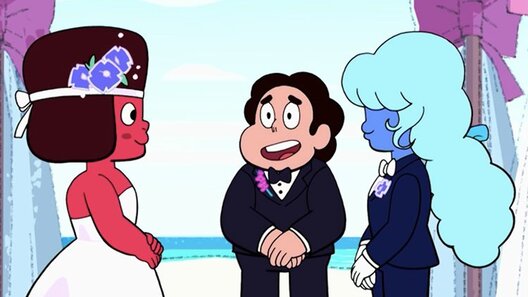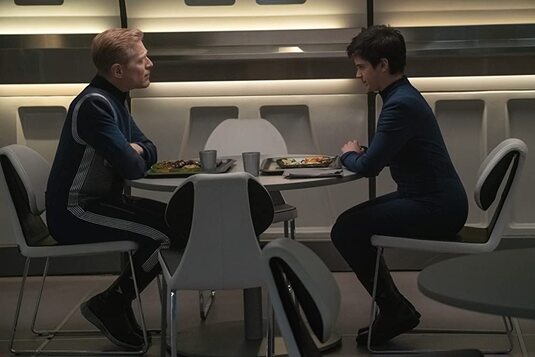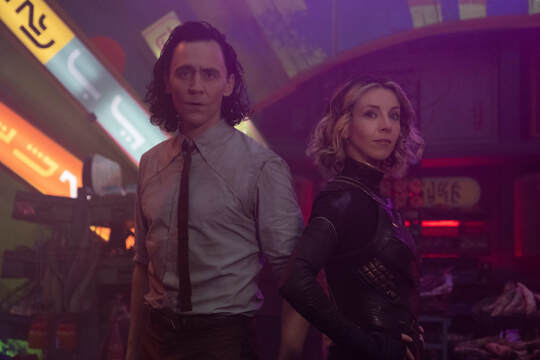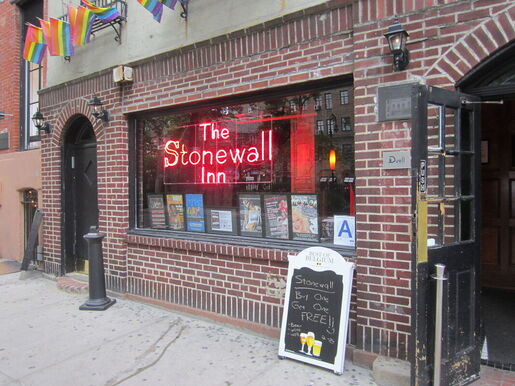Written by Shae Rufe  I have been struggling to find a proper closing on my thoughts for this month’s Pride. Obviously, Pride goes beyond just the month of June. For many it is something we live every day. Looking through the LGBTQ+ side of media, I was disheartened to see how far we haven’t come. There are very little Asexual or Intersexed characters. Very little representation of Queer or Pansexuals or Poly characters. Yes, there are more in Literature than anywhere else, and that is amazing. Literature is a broad and wonderful spectrum within Media that has given birth to some wonderful film and television adaptations. However, when it comes to having more exposure to various types of sexualities beyond the heteronormative, there is still such a huge lacking within visual media. We find ourselves at a point in history where things have to change. There is no reason why we cannot have a Trans woman of color on the big screen. Or two men sharing a romantic kiss at the end of a RomCom. The truth is, there have been and always will be LGBTQAI+ people around. We just got tired of hiding in closets and being shamed for being who we are. So, I thought I would include some statistics and talk about a very touchy subject on here. Warning for Suicide Triggers and Violent Crime Trigger warning. I’m not going to be going into too much graphic detail. I think hard facts are important when looking at things like this, especially with more sensitive subjects. As it turns out LGBTQAI+ Youth are 40% more likely to contemplate of consider suicide. LGBTQAI+ youth are twice as likely to have attempted suicide over heterosexual youth, especially under the age of 25. In fact, gay men are 79% more likely to attempt and succeed at suicide than women, closely followed by Transgender people. 28% of people forced into conversation therapy attempted suicide as a way out from it. And the likelihood of success goes up even further when violence is introduced. 40-47% of gay and bisexual men will experience domestic or sexual violence while 19%-29% of lesbian and bisexual women. 47% of Transgender people have experience violence against them. And 54% of Transgender people have experience domestic violence from a partner. I’m not going to go into more intimate details or more crimes. The numbers speak for themselves. I am personally a victim of violence and attempted suicide for my sexuality. I’m not ashamed of either experiences, because I have gotten to grow and see the world change and watch as our fight for equality gains more traction. I say this not to garner followership, sympathy, or anything of the sort. I say this because I am a person. I am more than my experiences, and I know that somewhere out there someone is hopefully reading this and feeling just a little less alone. That is the purpose of proper representation in media, to not feel alone. I was born in the mid 80s and proudly tout myself as a 90s kid. Well, sadly, there wasn’t a lot of acceptance then. LGBTQAI+ people were typically over exaggerated, harmful, stereotypes that were more caricature than reality. They were the butts of jokes or something to scoff at. In many cases, they did way more harm than good. They often lusted after the straight lead and were not too subtle about the whole thing. It was something to be ashamed of, being LGBTQAI+. Television, Film, Comics, Games, so much more, they have the power to actually change all of that. The problem is change is often too slow. Now, there has been some amazing headway. Cartoons such as Steven Universe and it’s Non-Binary creator Rebecca Sugar never would have been acceptable back then. Yet, today, kids can experience Ruby and Sapphire, two female presenting woman, kiss and watch their wedding and not have it be an oddity. It’s the perfect statement of Love being just Love. Because, at the very end of the day, Love is Love and the gender identity of whom you love is never wrong. The future of media needs to be more inclusive. America Chavez, a lesbian woman of color and superhero, deserves her own movie on the big screen. Disney Park’s offer ‘Gay Days’ where they celebrate Pride beyond just June and host an array of rainbow everything, however they have yet to give an LGBTQAI+ individual a lead role in any movie. The few things they have done have been either a background character that gets a same sex dance scene or a same sex kiss at the end of a movie for less than a second on screen. If we do not start giving proper representation within media and showcasing that being LGBTQAI+ is normal, we will not see those suicide rates drop. No, it is not solely on media, however representation and a sense of normalcy are the first steps.
0 Comments
Written by Shae Rufe  In doing my research for this next blog, I was really beyond let down. The lack of Transgender representation is so shockingly stark that it is discouraging. Most of my research proved that many Transgender characters in popular media were either one offs or mockeries. Perhaps the latter is my interpretation of the presentation of these characters, however the manner in which these characters were portrayed leads me to that mindset rather than seeing them as genuine. In some cases, my search led me to fan theories about certain characters being Transgender without any canonical backing. Like with Pidge in the Netflix revival of Voltron. Many fans wanted her to be Transgender or Non-Binary, but the truth is canonically she’s still Katie, who took on a different identity to find her brother. It’s never said in the show that Pidge is Transgender or Non-Binary. Of course, this is the same show that led us to believe we would get a possible romantic interest for Shiro, and in the very end we got one small cut scene with a past boyfriend and a three second still of a post-show wedding. Pidge could have been Transgender or Non-Binary, but the show never made it happen and the fans chose to pose their theories online. To me that just shows how desperate people are to have proper Transgender representation in media, because let’s face it, there truly isn’t enough. When there is a Transgender character, they’re often a side or one-off character, so far, not the main character. She-Ra and the Princesses of Power, another Netflix revival, features Jewelstar, a Transgender character voiced by a Transgender actor, however he is only featured in one single episode. That actually seems to be it for Transgender representation in modern day American Animation. Comics on the other hand have bigger wins. Batgirl, which ran from 2011-2016 gave us the first major Transgender character in a comic series in the form of Barbara Gordon’s roommate, Alysia Yeoh. Alysia comes out to Barbara as Transgender in the comics, and she’s also bisexual. It’s a wonderful moment for many fans and certainly a great one for comic readers. DC was the first major comic publisher to have a Transgender main character. Yet that seemed to be it when it came to further representation. There seems to be more representation in literature than any other form of media. While that isn’t a bad thing in the slightest, it is still disheartening that in 2021 Transgender representation in television and movies is floundering. For people to not see themselves within characters creates a disconnect. It’s important that we can look at characters and see our likeness within them. It helps people to connect and feel much less alone. Because if this hero or this character can go through hard situations and make it out okay, come out still a hero, then so can we. When it came to finding Non-Binary representation within media, I had a bit more luck but the list was still pretty small. Ironically, Steven Universe could technically be a show about a large number of Non-Binary characters. The Gems are technically neither male nor female, as their physical forms are self-chosen projections. However, all Gems use she/her pronouns. There was one exception, however, with Sadie’s partner, Shep. In the final season of Steven Universe, Future, we were introduced to Shep for a single episode, and they do use they/them pronouns. Which was really amazing to see, but again, was a short scene with a one-off side character. She-Ra and the Princesses of Power did offer more representation for Non-Binary characters with Double Trouble. While they aren’t a main character, they are around for 8 episodes, more than just a single, one-off passing. Star Trek: Discovery takes the cake with their Non-Binary character; Adira. They originally use she/her pronouns for the first few episodes, until they finally correct someone. The way Star Trek: Discovery handled this situation is how we should all handle changing someone’s pronouns. Adira asked to be referred to as they/them and everyone did. It’s literally that simple. Oddly enough there is further representation of Non-Binary in the book and show adaptation of Good Omens. The angels and demons are all Non-Binary, as stated by co-author Neil Gaiman. We see this with the Amazon live action adaptation in its showing of characters such as Beelzebub, Michael, and Pollution. Crowley is actually portrayed as more gender fluid and seems to slip between more masculine and feminine appearances more so than Aziraphale. It’s important as we continue on, to remember that all forms of representation are important. Although there have been major strides to have LGBTQA+ portrayals in media, we still have a long way to go in order to break out of the heteronormative narrative that has engrossed our media for decades. People come in various shades of the spectrum, and we need to have proper depictions of that. Specifically, beyond comics and literature, but on the big and small screens. It’s important that people not feel so alone and are able to connect with hero’s who are just like them. Written by Shae Rufe  It’s been an interesting Pride Month. First and foremost, the MCU finally gave us two bits of representation in the form of their newest show Loki and with its main character. Loki is officially both gender fluid and bisexual and it’s been a long time coming. Which, I suppose we need to be celebrating Sylvie as well! While the comics have given us the representation we deserve, there has been a surprising lack of it in other media platforms. Comics are a wonderful form of media, however they’re not as widespread and popularized as movies and TV. Representation is very important, especially when it comes to younger viewers. It can be extremely lonely when the heteronormativity of society is consistently pushed onto LGBTQA+ youth. As someone who very rarely had any lesbian representation growing up and has a psych degree, I feel qualified to say that it’s detrimental to development to not have that representation in mainstream media. People and families come in all different shapes, sizes, colors, and sexualities. No two families are the same. And while we still need more representation of BIPOC and mixed families, we also need more representation of sexualities. Well, I’m obviously not the only person who thinks like this because Blue’s Clues actually did something amazing this Pride Month. They aired a Parade of their own and they literally slayed it. They showed families of all types; some with two dads, some with two moms, some with non-binary members, trans members, and bisexual members. They covered a ton in such a short amount of time. That is what we need more of. Kids need to be able to see families just like theirs on TV and know that not only are they not alone, but they are just as important as heteronormative families. Speaking of families. While Marvel hasn’t brought more representation to the screen, just yet, they have introduced two more bisexual characters into the world. Granted, Billy and Tommy are just kids in WandaVision, but they do grow up to be bisexual men. In fact, Billy grows up to not only be Wiccan in the Young Avengers, he also grows up to marry Teddy, AKA Hulkling. Yes, it’s completely comic cannon. Whether we see this on the big or small screen, well that remains to be seen. Speaking of Bi characters, I unfortunately never watched the Harley Quinn animated show, but I did watch Birds of Prey. Harley’s bisexuality is glossed over in the movie, barely a snippet in the opening scene, she does go on to have a full relationship with Poison Ivy in the animated show. Not to mention in the comics. In fact, Harley is more than just bi, she’s also polyamorous. And yes, in case anyone was curious, I believe polyamorous relationships deserve representation as well. Everyone is different and unique, and everyone deserves to look at media and see themselves. Now I sadly never got a chance to see the new Batwoman show on the CW, yet that does not change the fact that we finally got a television show about a lesbian heroine. I have heard mixed opinions on the show itself, and I’m not going to argue any bit of whether it was good or bad or indifferent. I am literally just happy we finally had an adaptation of Batwoman on the small screen. You can be gay and still save the day. That’s how every single one of these characters should be viewed. There is also a rumor that we may get Valkyrie having a girlfriend in Thor: Love and Thunder. Does that mean she’s officially out as a lesbian character? I’m not sure, I am excited to see what they do with her character, and hopefully we do get to see a romantic interest for her that is indeed another woman. So far it seems like Marvel and DC are both willing to push more representation into their smaller and possibly bigger screen stories. However, when it comes to transgender people, non-binary, Asexual, and so on, there isn’t much representation in media, if any. Few iconic roles do stand out, such as Sophia Burset from Orange is the New Black. During my research I actually didn’t find as much representation for other members of the Alphabet Mafia as I had hoped. There is a startling disparity when it comes to the complete and total lack of visibility for transgender, non-binary, ace, gender queer, and many others within the spectrum. My thoughts on this part are so vast that I think it might have to be the next blog. Stay tuned because I have a lot of rants about the lack of representation for the other half of the LGBTQA+ community. Written by Shae Rufe  Guys, it is Pride Month and I have a lot to say about it. As the resident Lesbian at NTG, and self-proclaimed expert in all things nerdy, I felt it only appropriate to pay homage to all the LGBTQA+ characters and people who make our nerdy world go round. Today I wanted to focus on Pride Month itself, how it started, how it’s evolved, and how impactful and important it has been to all of society. After all, inclusion is very important and so is education. To be honest, I was in my late teens when I learned the true origins of Pride, and I feel it’s important to keep talking about it. This month is near and dear to my heart for many reasons, but above all, Pride has helped so many of us band together and not face life alone. As I started planning my blogs for this month, I didn’t expect to be quite as open as I am about to be, but I feel it’s extremely important to talk openly about things so that others, who may be experiencing something similar, can know they’re not alone. I intended for this blog to actually be out last week, and the words failed me at the time. For many of us, coming out is a scary thing to do. Having someone close to you do it for you, can be a truly harrowing experience. I was 16 when a friend of mine outed me to my parents. It was 2002, and back then people were still getting killed for being gay, and most teens and young adults were abandoned by their family. I was lucky, my parents are kind and accepting people. Many people aren’t that lucky, however. Many people still get disowned by their families. But while it is dangerous to come out, because you don’t know how someone’s family will react, it is still important to do it. Because you have to be true to yourself and so many are able to do that now because of the brave people that fought hard for us to be proud of who we are. That brings us to the origins of Pride. Now, a lot of memes have been going around this month about Pride. They’ve actually been going around for over a year now. Most say: “The first Pride was a Riot.” And they’re not wrong. The Stonewall Riots took place on June 28th. 1969 in Greenwich Village, New York. The Riots lasted from June 28th until July 3rd, and were a long time coming. Prior to the riots, police would often raid gay bars and clubs, or rumored gay hang outs. As we’ve seen over the past few years, police brutality is a horrific thing. On the morning of June 28th, police raided the Stonewall Inn. Accounts vary on how the riots really started. Some say someone threw a brick at police, others say it was rumors of police beating people inside the Stonewall Inn that ignited the violence outside. However, it’s one account of a woman being beaten by police and thrown into a wagon that supposedly sparked everyone into action. Many eyewitness accounts vary, but by the end of it, people were fighting against police. Stonewall is touted as being our first Pride. From there, LGBTQA+ people banded together and started demanding equal treatment. It’s a powerful movement that is still going on today. While there had been other movements for equality in the LGBTQA+ community, none had been as successful as Stonewall. The movement spread, and we today still keep fighting for equal rights. That has since expanded to include Black Lives, Native Lives, and Asian Lives. With the rise of COVID and the subsequent police brutality cases against people of color, the redesigned Pride Flag has been going strong and strives for inclusivity of all people. These movements are extremely important; for so long as one of us is not equal, none of us are equal. Of course Pride has been met with protests from opposing groups of varying religious backgrounds. However, the Pride Movement sill goes strong. We are just now having openly LGBTQA+ people in media more and more, and even expanding into media directed towards children. Last week, Blue’s Clues showed their support by showing how different families do exist. It’s important for kids to see those things, especially when they come from a family where they have two dads or two moms or have a transgender family member. Inclusivity is extremely important for your children to connect to and with. So far 2021 has proven to be a great year for things like that. I can only hope that the following years will continue to be even better. Without Stonewall, we wouldn’t be here today, celebrating this month. Many people fought hard to see their way of life normalized, and that fight is far from over. Major strides have been made in media to represent the LGBTQA+ community, and don’t worry, I will get into as much of that as I can next time! Photo Credit: User ‘Another Believer’ via Wikimedia Commons. No edits were made to this image. |
Archives
December 2024
|
|
© 2012-2025, Nerds That Geek LLC.
All Rights Reserved. |
uWeb Hosting by FatCow

